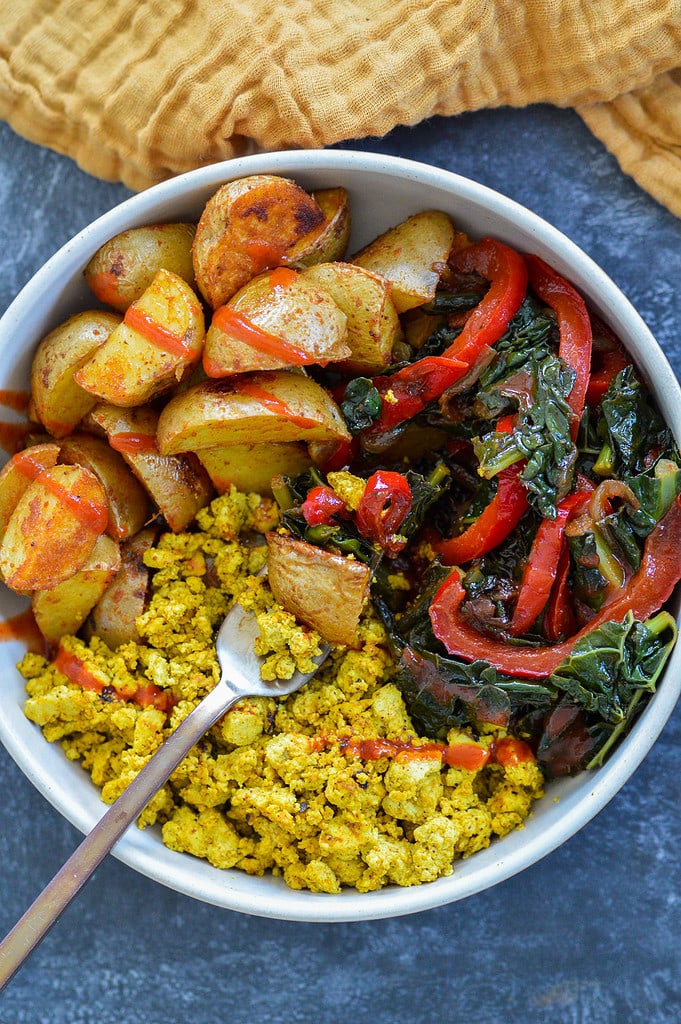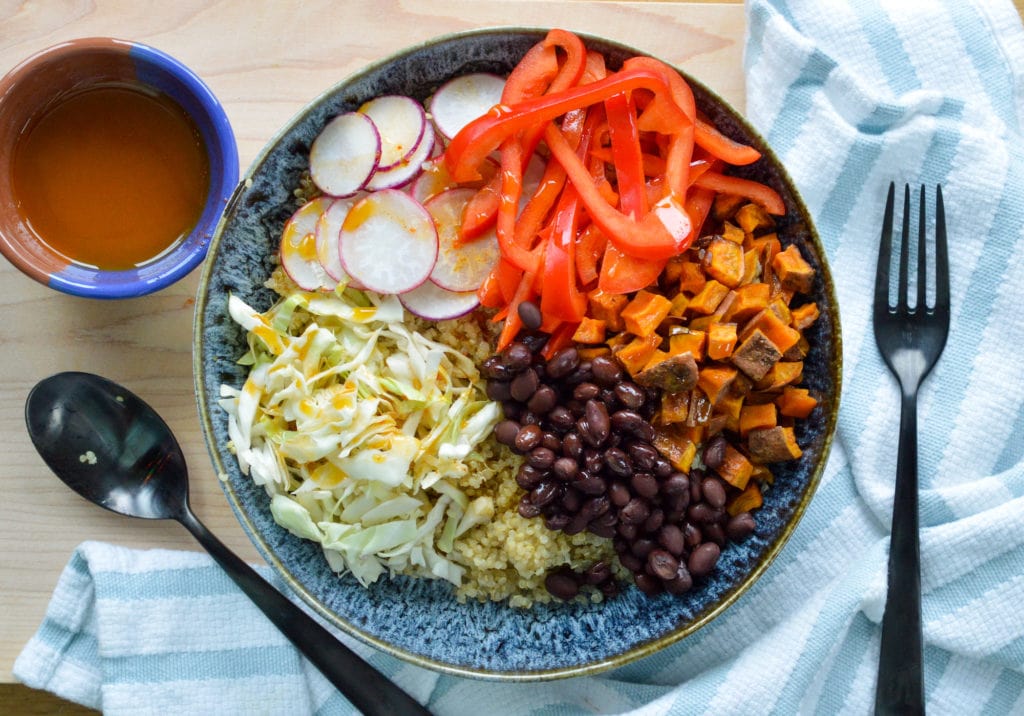“Gluten-free” is a phrase that has spread like wildfire over the last few years, and it’s often used to market packaged foods (spoiler alert–gluten-free oreos are not any healthier!). For athletes, going gluten-free may seem impossible since so many fueling carbs contain gluten.
But I’m here to tell you it’s absolutely doable! While it’s important to focus on the items that you need to eliminate, I also like to emphasize all of the amazing foods that you CAN eat.
It can often feel a bit overwhelming at first (especially for those with Celiac that can get extremely sick from consuming gluten), but eliminating gluten quickly turns into a way of life after a short period of time!
What is gluten?
First, let me say that going gluten-free is not necessary for a “healthy” diet–there are plenty of gluten “full” grains that are great for you! Yet, some people need to avoid gluten if they have Celiac Disease or an intolerance/sensitivity. Others just say they feel better when avoiding gluten.
If you’re new to the gluten-free life, here’s a quick rundown of what ‘gluten’ actually means.
The Celiac Disease Foundation defines gluten as the proteins found in wheat, rye, barley and triticale – a cross between wheat and rye. Gluten is often described as the “glue” that holds foods together, and the most common sources of gluten are found in:
- Wheat (breads, baked goods, pasta, cereal, sauces, wheat berries, durum, emmer, semolina, spelt, farina, farro, graham, KAMUT® khorasan wheat and einkorn)
- Barley (malt, soup, beer, brewer’s yeast)
- Rye (cereals, bread)
- Oats (unless specifically labeled gluten-free)
Quick rule of thumb – a nutrition label can only say “gluten-free” if it’s certified gluten-free by the FDA. If you’re not sure, check the ingredients on the nutrition label for any of the foods listed above.
Fruits, vegetables, beans, nuts and seeds are always gluten-free, unless they have a sauce, dressing or marinade.
What carbs are gluten-free?
You may naturally assume that a gluten-free diet means no carbs. This is absolutely not the case! You will find some of the best complex carbs don’t contain any gluten, such as:
- Whole grains – oats, quinoa, brown rice, sorghum, corn, millet, amaranth, teff,
- Fiber rich fruits– bananas, apples, berries
- Starchy Vegetables – sweet potato, corn, squash
- Legumes- beans, peas, lentils
- Nuts and seeds— chia, flax, hemp, poppy
If you buy canned, dried, frozen and pre-chopped fruits and vegetables, check the label to make sure they do not contain any gluten in the packaging. Also, if you opt for pasta, bread or other baked good with an untraditional flour (like almond), check the ingredients label to make sure there is no gluten-containing products.
There are also many gluten-free versions of traditional products in the grocery store these days.
How does a gluten-free diet impact athletic performance?
With the rise in popularity of a gluten-free diet, many athletes have eliminated gluten from their diet with the belief that it will improve their athletic performance. However, this is not necessarily the case.
There is currently only one study that has evaluated whether a gluten-free diet has any impact on athletic performance. The study found that a short-term gluten-free diet had no overall effect on performance, GI symptoms or inflammatory markers in non-celiac endurance athletes.
Simply put, there is no evidence that states a gluten-free diet improves athletic performance for athletes who do not have celiac disease. For athletes who are diagnosed with celiac disease, gluten elimination will significantly improve athletic performance and overall health.
When athletes follow a gluten-free diet, they are at greater risk of nutrient deficiencies from eliminating certain food groups.
Gluten is prevalent in carb-rich foods, which also contain important B Vitamins (thiamine, niacin, riboflavin, folate), iron, calcium, Vitamin D and fiber. A deficiency in any of these nutrients could negatively impact athletic performance and overall health.
On the upside, eating a gluten-free diet often removes unhealthy processed foods from your diet.
If you decide to go gluten-free, make sure you still eat plenty of grains without gluten, like the ones listed here!
Why do athletes follow gluten-free diets?
It may be your initial reaction to want to jump on the gluten-free bandwagon when you hear that professional athletes, like Novak Dokavic, dedicate their success to a gluten-free diet. But before you do so, it may be a good idea to understand why cutting gluten from your diet could potentially improve your performance.
Athletes who see an improvement in their GI symptoms after eliminating gluten from their diet may actually have a gluten intolerance. On the other hand, those who do not have a gluten intolerance may just be experiencing the benefits of consuming a less processed diet.
For example, some of your favorite post-workout energy bars contain gluten. Some athletes may find that eating whole foods for recovery instead of a bar may reduce GI symptoms. For these people, gluten is not the cause of the tummy issues, but rather certain foods.
The take-home message is that athletes who have a gluten intolerance will reap the benefits of eliminating gluten from their diet. But for those without an intolerance, eliminating processed gluten foods and consuming a healthier diet overall may lead to better health and improved athletic performance.
Is a gluten-free diet good for runners?
Unless it is medically necessary (like being diagnosed with celiac disease), runners should not give up gluten as part of their training diet. By cutting out gluten, runners may start to avoid entire food groups which could deprive the body of essential nutrients and energy needed to fuel the body when training.
Eliminating a number of foods from your diet could actually worsen GI symptoms and affect mood and health. Not to mention that a gluten-free diet often comes with higher grocery bills, as the cost of gluten-free products tends to be more expensive!
Gluten-free endurance athlete meal plan
Need some ideas on how to get started? Below are some examples of gluten-free meals that will fuel your body and keep you energized throughout the day.
Pre-workout breakfast options
- Overnight GF oats (soaked in dairy milk or plant-based milk of choice) topped with fruit of choice (½ banana and ½ cup of berries always works great) + 1-2 tablespoons nut butter (or plain nuts) + dash of cinnamon for taste.
- 2 scrambled eggs (eat the whole egg!), 1-2 pieces of gluten-free toast topped with nut butter or avocado, and 1-2 servings of fruit.
- Roasted potatoes, scrambled tofu and sauteed leafy greens

Pre-workout snack options
- Apple or banana with nut butter (or a handful of nuts).
- Greek yogurt (or plant-based yogurt) topped with fruit and nuts.
- Almond Butter Chocolate Chip Cookies made with gluten-free oats.

Lunch options
- Gluten free wrap filled with chickpeas, hummus, lettuce, cucumbers, and tomatoes.
- Lentil Salad with Sun-Dried Tomatoes & Feta

Dinner
- Tofu stir fry with brown rice (or cauliflower rice!), broccoli, peppers, onions, gluten free soy sauce or coconut aminos, tofu, and a side salad.
- Southwestern Quinoa Power Bowl

Recovery snacks
*Recovery snacks should be focused around protein, which most of the time is naturally gluten-free! Some ideas include the following –
- Nuts
- Roasted chickpeas
- Cottage cheese & fruit
- Oatmeal with fruit & nuts
Are there downsides to a gluten-free diet?
While a gluten-free lifestyle is completely manageable, there are definitely some common mistakes that many people make.
- Never assume a restaurant dish is gluten-free. Even if the meal description seems simple (like roasted Brussels sprouts), those veggies might be fried in the same oil as bread and other gluten-containing foods. It’s extremely important to speak with your waiter and mention your gluten allergy/preference since you never know what’s going on in the kitchen.
- Be wary of cross-contamination. If you have Celiac Disease or find yourself having a serious intolerance, cross-contamination is something that can make you very sick! For example, if you toast gluten-free bread in the same toaster as regular bread, the breadcrumbs can mix and create a gluten danger zone.
- Be careful of soups, sauces, and marinades. Wheat flour, soy sauce, and gluten-containing chicken/vegetable stock are often added into these foods, so be sure to read labels and ask when ordering at restaurants!
- Ask your doctor about medications, vitamins, and supplements. Unfortunately, many medications, vitamins, and supplements have gluten containing fillers added to them. Be sure to speak with your doctors and order vitamins/supplements from brands that are certified gluten free.
- Gluten Free doesn’t mean healthier. As mentioned in the beginning of this post, a gluten-free oreo is not healthier than a regular one! Gluten-free is often viewed as healthier since many people eat less processed foods and refined sugars when going gluten-free. But don’t fall victim to snacking on gluten-free cookies & cakes for your “health”.
If you’re new to the gluten-free life (or need a refresher) and have additional questions, feel free to reach out – always happy to help!


0 Comments